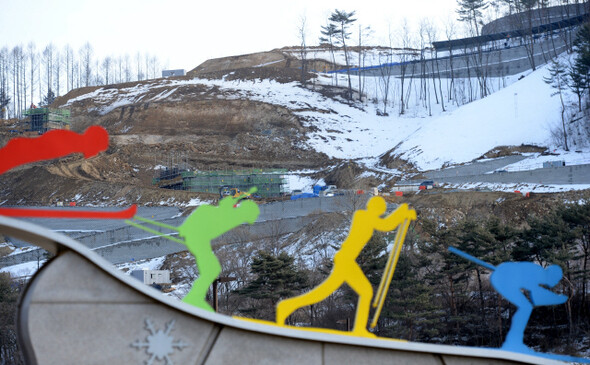hankyoreh
Links to other country sites 다른 나라 사이트 링크
After Pyeongchang Olympics, maintenance costs will run nearly $20 million a year


The yearly cost of maintaining the facilities used in the 2018 Pyeongchang Winter Olympics after the games are over is expected to be 21.05 billion won (US$18.89 million). Even if part of this cost can be covered by facility revenues, the huge maintenance cost is expected to leave Gangwon Province and other local governments with a yearly deficit of 16.59 billion won.
The figures indicate that politicians’ insistence on adhering to the original plan -and rejecting calls for event sharing - could lay waste to local budgets.
The Hankyoreh reached these conclusions by reviewing a feasibility study by the Korea Development Institute (KDI) with the help of an expert.
Gangwon Province, the central government, and the Pyeongchang Olympics Organizing Committee are stonewalling proposals to hold certain events at existing facilities, and the ramifications could be severe.
In order to maintain the sliding center currently being built in Pyeongchang after the Olympics are over, Gangwon Province will have to spend 3.17 billion won (US$2.84 million) a year. But operating the facility will hardly bring in any revenue.
The facility cannot be used at all during the summer, and even during the winter, there will be few patrons. As a result, just keeping the sliding center open will mean a loss of nearly 3 billion won each year.
“It would be more profitable just to tear the thing down,” said a senior official at the Ministry of Culture, Sports, and Tourism.
Aside from the women’s ice hockey rink being built inside Catholic Kwandong University in Gangneung and an existing facility being renovated as a curling rink, there are hardly any plans for using the new facilities being built for the Olympics.
It will cost 2.9 billion won simply to maintain the 10,000-seat men‘s hockey rink. With no prospects of being used, these facilities are ripe for demolition, but that would leave no legacy from the Olympics.
Another burden for the central and local governments is the Olympics budget, which continues to balloon. In the original bid for the Pyeongchang Olympics, the budget estimate was 8.8 trillion won (US$7.88 billion), but by now the total budget has grown to 13.48 trillion won. Factors such as inflation and design changes could drive the cost up even more.
Academics are in favor of event sharing for a number of reasons, such as improving return on investment, decreasing the maintenance cost after the games, and ensuring that a legacy is left.
“There are efforts to move the snowboard venue from Bokwang Phoenix Park to High 1 Resort in order to cut costs, but even a review of the proposal is being blocked out of concern that it will provoke more debate about event sharing. The organizing committee should be asking itself whether its attitude is what is provoking the debate. When the IOC first suggested event sharing, if President Park had taken it seriously instead of rejecting it out of hand, we would not be dealing with the current confusion,” said Jeong Yong-cheol, professor at Sogang University.
[%%IMAGE3%%]
By Yoon Hyung-joong and Heo Seung, staff reporters
Please direct questions or comments to [english@hani.co.kr]

Editorial・opinion
![[Editorial] Silence won’t save Yoon [Editorial] Silence won’t save Yoon](https://flexible.img.hani.co.kr/flexible/normal/500/300/imgdb/original/2024/0701/681719819632087.jpg) [Editorial] Silence won’t save Yoon
[Editorial] Silence won’t save Yoon![[Column] The miscalculations that started the Korean War mustn’t be repeated [Column] The miscalculations that started the Korean War mustn’t be repeated](https://flexible.img.hani.co.kr/flexible/normal/500/300/imgdb/original/2024/0630/9717197068967684.jpg) [Column] The miscalculations that started the Korean War mustn’t be repeated
[Column] The miscalculations that started the Korean War mustn’t be repeated- [Correspondent’s column] China-Europe relations tested once more by EV war
- [Correspondent’s column] Who really created the new ‘axis of evil’?
- [Editorial] Exploiting foreign domestic workers won’t solve Korea’s birth rate problem
- [Column] Kim and Putin’s new world order
- [Editorial] Workplace hazards can be prevented — why weren’t they this time?
- [Editorial] Seoul failed to use diplomacy with Moscow — now it’s resorting to threats
- [Column] Balloons, drones, wiretapping… Yongsan’s got it all!
- [Editorial] It’s time for us all to rethink our approach to North Korea
Most viewed articles
- 1Yoon’s prosecutors are throwing everything at the president’s opponents to see what’ll stick
- 2[Column] The miscalculations that started the Korean War mustn’t be repeated
- 3[Editorial] Silence won’t save Yoon
- 4Japan is building a military meant for more than self-defense — and has the US to thank for it
- 5NewJeans rocks Tokyo Dome as new, younger generation of K-pop fans emerges in Japan
- 6[Editorial] Exploiting foreign domestic workers won’t solve Korea’s birth rate problem
- 7Dreams of a better life brought them to Korea — then a tragic fire tore them apart
- 8[News analysis] Kim Yong-chol’s Washington, DC, a positive signal for 2nd NK-US summit
- 9Kim Jong-un says N. Korean nukes aren’t just for deterrence
- 10[Editorial] Seoul failed to use diplomacy with Moscow — now it’s resorting to threats